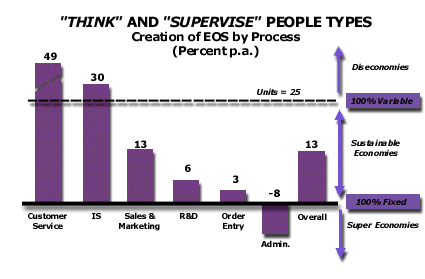BASIC STRATEGY GUIDE: STEP 29
Activity Four:
Manage the Company’s cost structure to create Economies of Scale while offering good value to Core customers.
Step 29: Measure Economies of Scale by type of employee
 |
What:
Measure the Economies of Scale with the most expensive People in the Company. Divide the Company’s total Input, People, into at least three categories of Full Time Equivalent (FTE): Think, Supervise and, Do employees. Because “Think” and “Supervise” FTEs cost so much more per FTE than “Do” employees, focus on those two employee categories in measuring Economies of Scale in each of the Company’s organizational units. Measure the Economies of Scale that each functional cost organizational unit produces with each type of employee.
Economies of Scale occur when units of Output grow faster than do the numbers of FTEs producing the Output. Diseconomies of Scale occur when numbers of FTEs producing products grow faster than the units of Output. Super Economies of Scale occur when FTEs actually decline while the units of Output rise.
In the illustration, the Company has unit sales growth at a rapid 25% per annum. As long as numbers of people are growing between 0% and 25%, the functional cost organization creates sustainable Economies of Scale. Should any type of employee grow faster than 25% per annum, the functional cost organization would be creating Diseconomies of Scale. If any type of employee should shrink in total numbers, the functional cost organization would be creating Super Economies of Scale.
Why:
Management employees (the “Think” people) cost substantially more than “Supervise” people, who, in turn, are more expensive then are the direct line people, the “Do” people. The Company should recognize these different costs per employee and adjust its efforts toward creating Economies of Scale with each type of FTE, but especially with Think and Supervise People.
What to Watch For:
-
Functional cost organizations will have significantly different rates of creation of Economies of Scale. The Company should understand the reasons for these varying rates.
-
The Company should begin using these analytical techniques with its Sales, General and Administrative functions and its People Inputs. As it becomes adept at using these techniques, the Company may migrate them to the broader operations of the Company and to the Purchases and Capital Inputs.
-
Economies of Scale should increase as the salary level increases. The Company would expect “Think” employees to grow significantly slower than do “Supervise” and “Do” employees.
-
In many companies, technology has had the effect of significantly raising the Productivity (i.e., reducing FTE/Output) of “Do” people and, secondarily, “Supervise” people. “Think” people have been far less affected by the growth in technology.
-
The growth in technology and decentralization of overhead functions would account for most of the cases of Super-economies of Scale in functional cost organizations.
Action:
Develop plans to insure appropriate Economies of Scale for “Think” and “Supervise” FTEs in the Company.
-
Self Test #29: Measure Economies of Scale by Type of Employee
-
Worksheet #29: Measure Economies of Scale by Type of Employee
More Information on Measuring Economies of Scale by People Type on the Advanced Site>>
For helpful context on this step:
Videos:
Perspectives:
Symptoms and Implications:
